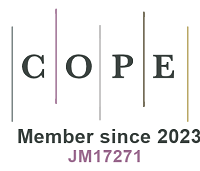REFERENCES
1. Ahmed, S.; Khan, F. S. A.; Mubarak, N. M.; et al. Emerging pollutants and their removal using visible-light responsive photocatalysis - a comprehensive review. J. Environ. Chem. Eng. 2021, 9, 106643.
2. Lykos, C.; Kourkouta, T.; Konstantinou, I. Study on the photocatalytic degradation of metronidazole antibiotic in aqueous media with TiO2 under lab and pilot scale. Sci. Total. Environ. 2023, 870, 161877.
3. Antonopoulou, M.; Kosma, C.; Albanis, T.; Konstantinou, I. An overview of homogeneous and heterogeneous photocatalysis applications for the removal of pharmaceutical compounds from real or synthetic hospital wastewaters under lab or pilot scale. Sci. Total. Environ. 2021, 765, 144163.
4. Kaur, A.; Umar, A.; Kansal, S. K. Heterogeneous photocatalytic studies of analgesic and non-steroidal anti-inflammatory drugs. Appl. Catal. A. Gen. 2016, 510, 134-55.
5. Kosma, C. I.; Kapsi, M. G.; Konstas, P. G.; et al. Assessment of multiclass pharmaceutical active compounds (PhACs) in hospital WWTP influent and effluent samples by UHPLC-Orbitrap MS: temporal variation, removals and environmental risk assessment. Environ. Res. 2020, 191, 110152.
6. Paíga, P.; Correia, M.; Fernandes, M. J.; et al. Assessment of 83 pharmaceuticals in WWTP influent and effluent samples by UHPLC-MS/MS: hourly variation. Sci. Total. Environ. 2019, 648, 582-600.
7. Hernando, M. D.; Mezcua, M.; Fernández-Alba, A. R.; Barceló, D. Environmental risk assessment of pharmaceutical residues in wastewater effluents, surface waters and sediments. Talanta 2006, 69, 334-42.
8. Gopinath, K. P.; Madhav, N. V.; Krishnan, A.; Malolan, R.; Rangarajan, G. Present applications of titanium dioxide for the photocatalytic removal of pollutants from water: a review. J. Environ. Manage. 2020, 270, 110906.
9. Frédéric, O.; Yves, P. Pharmaceuticals in hospital wastewater: their ecotoxicity and contribution to the environmental hazard of the effluent. Chemosphere 2014, 115, 31-9.
10. Hwang, S.; Kim, J. H.; Jo, S. H. Inhibitory effect of the selective serotonin reuptake inhibitor paroxetine on human Kv1.3 channels. Eur. J. Pharmacol. 2021, 912, 174567.
11. Silva, L. J.; Pereira, A. M.; Meisel, L. M.; Lino, C. M.; Pena, A. A one-year follow-up analysis of antidepressants in Portuguese wastewaters: occurrence and fate, seasonal influence, and risk assessment. Sci. Total. Environ. 2014, 490, 279-87.
12. Santoke, H.; Cooper, W. J. Environmental photochemical fate of selected pharmaceutical compounds in natural and reconstituted Suwannee River water: role of reactive species in indirect photolysis. Sci. Total. Environ. 2017, 580, 626-31.
13. Gornik, T.; Carena, L.; Kosjek, T.; Vione, D. Phototransformation study of the antidepressant paroxetine in surface waters. Sci. Total. Environ. 2021, 774, 145380.
14. Kwon, J. W.; Armbrust, K. L. Hydrolysis and photolysis of paroxetine, a selective serotonin reuptake inhibitor, in aqueous solutions. Environ. Toxicol. Chem. 2004, 23, 1394-9.
15. Carvalho, P. S.; de, M. C. C.; Ayala, A. P.; Ellena, J. X-Ray diffraction, spectroscopy and thermochemical characterization of the pharmaceutical paroxetine nitrate salt. J. Mol. Struct. 2016, 1118, 288-92.
16. Gurke, R.; Rößler, M.; Marx, C.; et al. Occurrence and removal of frequently prescribed pharmaceuticals and corresponding metabolites in wastewater of a sewage treatment plant. Sci. Total. Environ. 2015, 532, 762-70.
17. Lajeunesse, A.; Smyth, S. A.; Barclay, K.; Sauvé, S.; Gagnon, C. Distribution of antidepressant residues in wastewater and biosolids following different treatment processes by municipal wastewater treatment plants in Canada. Water. Res. 2012, 46, 5600-12.
18. Metcalfe, C. D.; Chu, S.; Judt, C.; et al. Antidepressants and their metabolites in municipal wastewater, and downstream exposure in an urban watershed. Environ. Toxicol. Chem. 2010, 29, 79-89.
19. Schlüsener, M. P.; Hardenbicker, P.; Nilson, E.; Schulz, M.; Viergutz, C.; Ternes, T. A. Occurrence of venlafaxine, other antidepressants and selected metabolites in the Rhine catchment in the face of climate change. Environ. Pollut. 2015, 196, 247-56.
20. Yuan, S.; Jiang, X.; Xia, X.; Zhang, H.; Zheng, S. Detection, occurrence and fate of 22 psychiatric pharmaceuticals in psychiatric hospital and municipal wastewater treatment plants in Beijing, China. Chemosphere 2013, 90, 2520-5.
21. Duarte, P.; Almeida, C. M. R.; Fernandes, J. P.; et al. Bioremediation of bezafibrate and paroxetine by microorganisms from estuarine sediment and activated sludge of an associated wastewater treatment plant. Sci. Total. Environ. 2019, 655, 796-806.
22. Ebele, A. J.; Abou-Elwafa, A. M.; Harrad, S. Pharmaceuticals and personal care products (PPCPs) in the freshwater aquatic environment. Emerg. Contam. 2017, 3, 1-16.
23. Li, R.; Li, T.; Zhou, Q. Impact of titanium dioxide (TiO2) modification on its application to pollution treatment - a review. Catalysts 2020, 10, 804.
24. Oturan, M. A.; Aaron, J. Advanced oxidation processes in water/wastewater treatment: principles and applications. a review. Crit. Rev. Env. Sci. Tec. 2014, 44, 2577-641.
25. Antoniou, M. G.; Zhao, C.; O’shea, K. E.; et al. CHAPTER 1. Photocatalytic degradation of organic contaminants in water: process optimization and degradation pathways. In: Dionysiou DD, Li Puma G, Ye J, Schneider J, Bahnemann D, editors. Photocatalysis. Cambridge: Royal Society of Chemistry; 2016. pp. 1-34.
26. Fotiou, D.; Lykos, C.; Konstantinou, I. Photocatalytic removal of the antidepressant fluoxetine from aqueous media using TiO2 P25 and g-C3N4 catalysts. J. Environ. Chem. Eng. 2024, 12, 111677.
27. Vagi, M. C.; Petsas, A. S. Recent advances on the removal of priority organochlorine and organophosphorus biorecalcitrant pesticides defined by Directive 2013/39/EU from environmental matrices by using advanced oxidation processes: an overview (2007-2018). J. Environ. Chem. Eng. 2020, 8, 102940.
28. Zhu, D.; Zhou, Q. Action and mechanism of semiconductor photocatalysis on degradation of organic pollutants in water treatment: a review. Environ. Nanotechnol. Monit. Manag. 2019, 12, 100255.
29. Suleiman Khasawneh O, Palaniandy P. Removal of organic pollutants from water by Fe2O3/TiO2 based photocatalytic degradation: a review. Environ. Technol. Innov. 2021, 21, 101230.
30. Fujishima, A.; Rao, T. N.; Tryk, D. A. Titanium dioxide photocatalysis. J. Photoch. Photobio. C. 2000, 1, 1-21.
31. Katal, R.; Masudy-Panah, S.; Tanhaei, M.; Farahani, M. H. D. A.; Jiangyong, H. A review on the synthesis of the various types of anatase TiO2 facets and their applications for photocatalysis. Chem. Eng. J. 2020, 384, 123384.
32. Velempini, T.; Prabakaran, E.; Pillay, K. Recent developments in the use of metal oxides for photocatalytic degradation of pharmaceutical pollutants in water - a review. Mater. Today. Chem. 2021, 19, 100380.
33. Gaya, U. I.; Abdullah, A. H. Heterogeneous photocatalytic degradation of organic contaminants over titanium dioxide: a review of fundamentals, progress and problems. J. Photoch. Photobio. C. 2008, 9, 1-12.
34. Mccullagh, C.; Skillen, N.; Adams, M.; Robertson, P. K. Photocatalytic reactors for environmental remediation: a review. J. Chem. Tech. Biotech. 2011, 86, 1002-17.
35. Rapti, I.; Kosma, C.; Albanis, T.; Konstantinou, I. Solar photocatalytic degradation of inherent pharmaceutical residues in real hospital WWTP effluents using titanium dioxide on a CPC pilot scale reactor. Catal. Today. 2023, 423, 113884.
36. Spasiano, D.; Marotta, R.; Malato, S.; Fernandez-Ibañez, P.; Di, S. I. Solar photocatalysis: materials, reactors, some commercial, and pre-industrialized applications. A comprehensive approach. Appl. Catal. B. Environ. 2015, 170-1, 90-123.
37. Sundar, K. P.; Kanmani, S. Progression of photocatalytic reactors and it’s comparison: a review. Chem. Eng. Res. Des. 2020, 154, 135-50.
38. Brienza, M.; Mahdi, A. M.; Escande, A.; et al. Use of solar advanced oxidation processes for wastewater treatment: follow-up on degradation products, acute toxicity, genotoxicity and estrogenicity. Chemosphere 2016, 148, 473-80.
39. Fernández-Ibáñez, P.; Blanco, J.; Malato, S.; de, N. F. J. Application of the colloidal stability of TiO2 particles for recovery and reuse in solar photocatalysis. Water. Res. 2003, 37, 3180-8.
40. Sousa, M.; Gonçalves, C.; Vilar, V. J.; Boaventura, R. A.; Alpendurada, M. Suspended TiO2-assisted photocatalytic degradation of emerging contaminants in a municipal WWTP effluent using a solar pilot plant with CPCs. Chem. Eng. J. 2012, 198-9, 301-9.
41. Konstas, P.; Kosma, C.; Konstantinou, I.; Albanis, T. Photocatalytic treatment of pharmaceuticals in real hospital wastewaters for effluent quality amelioration. Water 2019, 11, 2165.
42. Babaeivelni, K.; Khodadoust, A. P. Adsorption of fluoride onto crystalline titanium dioxide: effect of pH, ionic strength, and co-existing ions. J. Colloid. Interface. Sci. 2013, 394, 419-27.
43. Antonopoulou, M.; Dormousoglou, M.; Spyrou, A.; Dimitroulia, A. A.; Vlastos, D. An overall assessment of the effects of antidepressant paroxetine on aquatic organisms and human cells. Sci. Total. Environ. 2022, 852, 158393.
44. Cunningham, V. L.; Constable, D. J.; Hannah, R. E. Environmental risk assessment of paroxetine. Environ. Sci. Technol. 2004, 38, 3351-9.
45. Dmitriev, A.; Rudik, A.; Filimonov, D.; et al. Integral estimation of xenobiotics’ toxicity with regard to their metabolism in human organism. Pure. Appl. Chem. 2017, 89, 1449-58.
46. Diniz, R. R.; Domingos, T. F. S.; Pinto, G. R.; Cabral, L. M.; de, P. M.; de Souza, A. M. T. Use of in silico and in vitro methods as a potential new approach methodologies (NAMs) for (photo)mutagenicity and phototoxicity risk assessment of agrochemicals. Sci. Total. Environ. 2023, 904, 167320.
47. Toropova, A. P.; Toropov, A. A.; Roncaglioni, A.; Benfenati, E. The enhancement scheme for the predictive ability of QSAR: a case of mutagenicity. Toxicol. In. Vitro. 2023, 91, 105629.
48. Gómez-Regalado, M. D. C.; Martín, J.; Santos, J. L.; Aparicio, I.; Alonso, E.; Zafra-Gómez, A. Bioaccumulation/bioconcentration of pharmaceutical active compounds in aquatic organisms: assessment and factors database. Sci. Total. Environ. 2023, 861, 160638.
49. Khan, K.; Kumar, V.; Colombo, E.; Lombardo, A.; Benfenati, E.; Roy, K. Intelligent consensus predictions of bioconcentration factor of pharmaceuticals using 2D and fragment-based descriptors. Environ. Int. 2022, 170, 107625.
50. Sousa, M.; Gonçalves, C.; Pereira, J. H.; Vilar, V. J.; Boaventura, R. A.; Alpendurada, M. Photolytic and TiO2-assisted photocatalytic oxidation of the anxiolytic drug lorazepam (Lorenin® pills) under artificial UV light and natural sunlight: a comparative and comprehensive study. Sol. Energy. 2013, 87, 219-28.
51. Wetchakun, K.; Wetchakun, N.; Sakulsermsuk, S. An overview of solar/visible light-driven heterogeneous photocatalysis for water purification: TiO2- and ZnO-based photocatalysts used in suspension photoreactors. J. Ind. Eng. Chem. 2019, 71, 19-49.
52. Chen, D.; Cheng, Y.; Zhou, N.; et al. Photocatalytic degradation of organic pollutants using TiO2-based photocatalysts: a review. J. Clean. Prod. 2020, 268, 121725.
53. Chong, M. N.; Jin, B.; Chow, C. W.; Saint, C. Recent developments in photocatalytic water treatment technology: a review. Water. Res. 2010, 44, 2997-3027.







